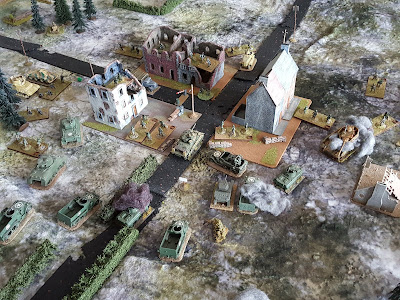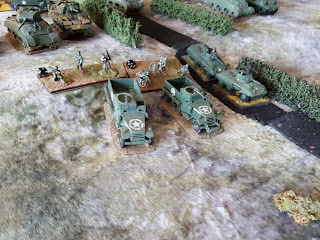And so to battle, and as usual, this one is 'picture heavy'...
The scenario is based on that outlined in 'Battles for the West Vol II' for the Panzergrenadier WWII rules by Dave Brown, as opposed to the wider scenario once available in Mark Bevis's 'WWII Battlezones' from 1989 (though maps from all books are shown at the very end).
Iron Cross is slimline and leaves a lot out - but any experienced wargamers can fill in the blanks.
The good stuff from the rules:
- The activation rules give a lot of tense action and drama.
- You MUST support your armour with infantry if you want it to survive.
- As with 7dtrr - there is a lot of detail missing - but that's a bonus for maintaining concentration on the game. Some of the more obvious issues are actually clarified in 7dttrr.
The bad stuff:
- Some of the missing rules - such as infantry assault techniques - make things a little one sided and/or alien in terms of understanding best tactics. Taking Stoumont became a shooting match rather than a protracted attack/counter-attack. But to put in additional assault rules would probably not help the ethos of the game. That said, there are some obvious omissions.
- There are so many markers - now granted I used luminous green puff balls and dice. Next time I'll opt for black tiddly-winks or something less obvious, but I ended up removing some of the green stuff before taking the latter pics.
- I think the successful management of the units/rules tapers off after 15-18 units. We had over 20 each in this instance, and though manageable, it meant that activations and switchovers were constant, and sometimes became a headache - while there was still a good stock/bank of command tokens to burn through. Although this ties in neatly with the spirit of the rules, it flies a little in the face of practicality - so perhaps a smaller scenario might have been more pertinent in this instance - or even a scaling up of the armour such that one model represented 3 vehicles etc.
US units move toward the town.
...which is well defended.
The Tiger II rolls every time it moves. On a '6', it runs out of fuel and becomes a (relatively strong) well armed pillbox.
Panzer Grenadiers well positioned to respond to any incursion.
...with armoured support.
Early armoured assault on the US right.
...while some Panzer IV cover helps on the main road in.
'Sieben hundert meter! Feuer!'
The mad Panther decides to go on a repeatedly activated dash for the US flank.
Infantry dismounts are initially driven back by the volume of fire from the defenders.
...while an M10 and a Sherman 76 try to put a dent in the German flank. This was never going to end well...
(Had I mentioned that it wasn't going to end well?)
The Tiger tries a move...and runs out of fuel.
There's a lot of US infantry moving in on the flank, but it will take time for it to make a difference.
'Where the hell did that Panther come from?'
Command Tokens 'r' us
Getting things together in the centre, the US forces gather for an assault.
On the US right, panzershrecks are making a mess, in addition to the Tiger and PzIV.
(The 3" bases worked well for infantry)
Additional US armour committed to the flank problem.
...while on the opposite flank, a company of US infantry is about to hit its objective.
Neatly timed with a massive assault in the centre. The Germans tried to react twice to this and failed.
It's a thin defensive line, as the Germans decide to concentrate their forces in the town, rather than outside. This would prove to be a critical error.
Panzergrenadiers race to the open flank, but it may be too late already.
...as that flank problem is resolved...
The US turn their right flank, concentrating more and more Bazooka fire on the stranded Tiger.
Attacks against Stoumont go in, are repulsed, and go in again.
Too much US infantry causing problems against the weak German flank.
German defenders withdraw from one town sector after the second US attack.
.50 Cals always help...
The Tiger II succumbs to sticky bombs and Bazooka fire...
German forces withdrawing fast from the rest of Stoumont, but they still hold the Sanitorium.
By this stage however, their break point is VERY close.
US forces finally secure the Sanitorium. Despite the Germans still holding part of the town, their break point has been reached, and they withdraw. A good game.
(Some reference maps)




























































Thank you, I really enjoyed that ... and am going to read it again now :-) I just can't properly make my mind up about these rules and now have both Iron Cross and 7 days.
ReplyDeleteHi Norm,
DeleteI'm having trouble now myself. SDTTRR does what I wanted for moderns, and boiled everything down the main differences between Soviet numbers and NATO quality.
Now, that's not the same for WWII, and we suffered this time from having just too many units.
Now, granted, it did what I like, in that the focus of the battlefield stays in certain 'zones' when it's important to remain focused (the flank for instance), but managing the numbers became problematic, although we did see the absolute disaster that happens when you run out of command chits. The Germans suffered horribly at the end when the US simply dictated play and moved into the town.
Infantry is hard to shift, but do enough damage and the player withdraws of their own volition to try and take stock - so that's a nice mechanism.
I'm thinking we had a few too many vehicles in this instance which complicated the matter needlessly.
Perhaps need to try a Normandy scenario with more infantry and less tanks.
Interesting, I have a part completed blog post in which I looked at a small number of units in a small space, the idea being to see how far I could take the command system in terms of smallness of scenario and for it still to be viable, you have gone the other way and it seems that there is perhaps somewhere a Goldilocks sweet spot exists re scenario size. Of course, it may be simply a case that no matter how nice the ideas or clever the system, it might not make for the best game. The last time I was looking at this I felt that the ‘wanting’ it to work was a powerful force, but that play was giving me less excitement than I expected. Perhaps I just need to get this back on the table and try again. The two rulebooks have all the potential for a ‘go to’ system.
DeleteI know what you mean Norm.
DeleteSomehow the 7dttrr game seemed more fluid, yet it was simply an assault/attack trying to achieve a breakthrough. One would have thought that a more dynamic game, with action on the flank like Stoumont, would have yielded more from the system.
As you say - it could be numbers; perhaps there is something analogous to Maurice by Sam Mustafa. He restricts the number of units per side to 12-13 in that game - clearly because he has playtested it at higher (and lower) levels and found it wanting. I think he even mentions this on his forum/design notes. Perhaps that didn't happen with these rules enough.
Very nice pics and AAR!
ReplyDeleteThanks Ski.
DeleteThere's a nice set of reaction rules in there, but I think we had too many units in this case.
Epic action, Darren! Loved it! We, too, played Iron Cross yesterday, instead of 7D as originally though. We actually looked to the 7D book to clarify a few unanswered things within Iron Cross.
ReplyDeleteI think your observations are fair regarding the strengths and weaknesses of the game system. There are some conceptual things I really like in these rules especially the ability to really "model" the initiative where you can dictate what the enemy will do with an aggressive plan. It's about as far from an IGOUGO game as one can get.
I like the necessity to use support weapons, so critical in real battle, to lay covering fire for offensive troops. With the use of an element on overwatch (with plenty of reserve command tokens) you can advance with some confidence knowing that if the enemy pops up or attempts to halt you, you can stop him.
To your point about too many units, and I'm glad you commented Norm, I'm going to try Iron Cross with Norm's "FOLLOW THE ELEFANTS" scenario from Tigers at Minsk, which is literally 4 to 7 elements on a side with 2 x extra command tokens for the platoon leader, to see how that goes.
Yesterday's game I had 12 units and Ken had about 24.
Thanks Steve.
DeleteWill be great to see your report.
I think if we had had less German units on one side, we wouldn't have had the issue - more akin to your 12 vs 24. That would have made things manageable, as the German player would have been forced to husband resources, while the American would have wanted to make grand tactical moves.
Maybe that's what we missed in terms of scope/scale.
'7D' is a far superior acronym for 7dttrr. We must use it from now on LOL
Now that you mention 'T.a.M.'. I need to get a game of that in too :)
7D it is then, sir! :)
ReplyDeleteJust saw your brilliant post mate.
DeleteI'm going to try the game again - with proper point spread and a scenario from the book.
Perhaps using a scenario from another rules set doesn't work as well as I'd hoped, and the pre-programmed scenarios make for a better game.
Will try this again.
Not my period, but looks great regardless!
ReplyDeleteThank you sir.
DeleteMore to come I think.
A set with limits no doubt. But the 'toys' look excellent.
ReplyDeleteMany thanks.
DeleteI may run the same game with Point of Attack - at platoon level - so a stand is a squad.
Ultimately this is the same scale, but it would be nice to see how it would work.
What changes did you make for PoA - I assume d12 instead of d20, and end the phase when the cards have been played?
Hi Duc,
ReplyDeleteNice game, I'm really liking this system. At this rate I'll have to get 1914 as well!
Cheers
Jay
Thanks Jay
ReplyDeleteYes - I was trying not to buy 1914, but there is a certain pull to WWI East Africa which I think this system might lend itself to.
Not a period or game system I know much about, but great pictures - gripping stuff. It would be too embarrassing to admit that I clicked on the post because I thought it said "Stormont", so I'll just keep quiet about that.
ReplyDeleteHaHa I love it. Do you know, I have been looking at that post again and again, convinced that it says Stormont myself.
DeleteNo, it's Stoumont in 1944, where two great power blocs faced off against each other after years of war, in the bitter cold - hey...wait a minute, isn't that ...?